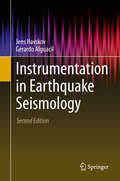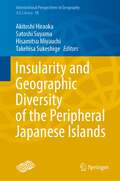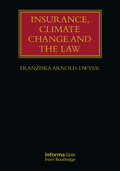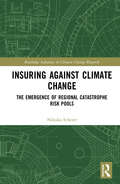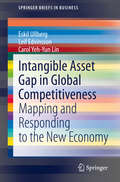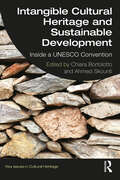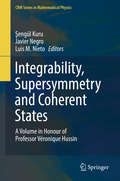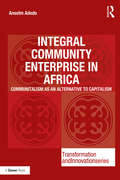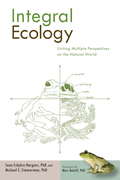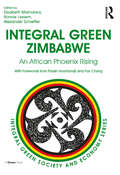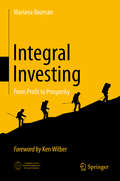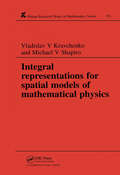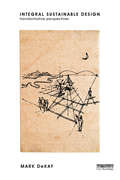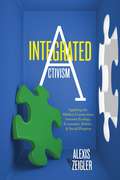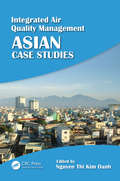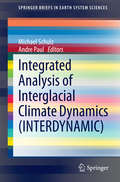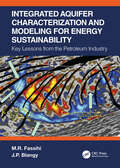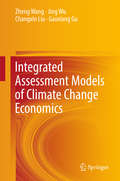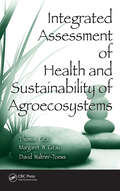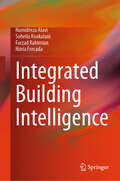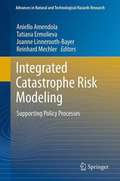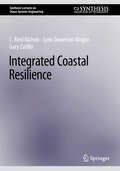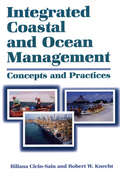- Table View
- List View
Instrumentation in Earthquake Seismology
by Jens Havskov Gerardo AlguacilThis work provides an up-to-date overview of modern instruments used in earthquake seismology as well as a description of theoretical and practical aspects of seismic instrumentation. The main topics are: * Choosing and installing equipment for seismic stations * Designing and setting up seismic networks and arrays * Maintaining and calibrating seismic instruments It also provides detailed descriptions of the following: * Seismic sensors * Digitizers * Seismic recorders * Communication systems * Software used for seismic station and networks In this second edition, new seismic equipment is presented and more comprehensive sections on topics like MEMS accelerometers, sigma-delta AD converters, dynamic range discussion and virtual networks have been included. This book is primarily intended for seismologists, engineers and technicians working with seismological instruments. It combines practical "know-how" with sufficient theory to explain the basic principles, making it also suitable for teaching students the most important aspects of seismic instrumentation. The book also gives a current overview of the majority of instruments and instrument manufacturers on the market, making it easy to compare the capability of instruments from different sources. SEISAN software was used for several examples in the book. This widely extended seismic analysis software is freely available from the University of Bergen website. The content of this book draws on the authors' (a seismologist and a physicist) combined experience of working in this field for more than 35 years.
Insularity and Geographic Diversity of the Peripheral Japanese Islands (International Perspectives in Geography #18)
by Akitoshi Hiraoka Satoshi Suyama Hisamitsu Miyauchi Takehisa SukeshigeThis book clarifies the geography of the peripheral Japanese islands from a variety of angles. The islands are distributed in the tropical and cool temperate zones, and the most distant inhabited islands are more than 1,000 km from the mainland. In the past, they were Japan's frontier, close to neighboring countries. However, during Japan's modernization process, the islands were positioned as backward regions, supplying food, resources, and labor. Today, the islands are considered to be on the periphery of Japan, with lifestyles different from those of the mainland. The islands are also getting attention as sightseeing locales and emigration regions attracting those who prefer country life—an image of the islands that has been created by the romanticized gaze from the Japanese mainland. The authors describe the various forms of the outlying Japanese islands and at the same time discover their common regional characteristics, as defined by the view from the mainland.
Insurance, Climate Change and the Law (ISSN)
by Franziska Arnold-DwyerThe insurance industry has found itself at the front line of climate change challenges, providing insurance cover in relation to risks associated with climate change. As risk carriers, insurers pay claims for climate change related losses – such as property damage caused by windstorms, flooding, and wildfires – which have been increasing in frequency and severity.As major institutional investors, insurance companies invest in assets that may be increasingly vulnerable to climate risks. Insurance regulators across the globe have therefore started to require insurance companies to identify, manage, and report on climate change risks that could pose a threat to their financial stability. However, managing and reporting on the effect of climate risk on an insurer’s balance sheet is an inward-looking perspective that does not stem climate change. It needs to be paired with an outward-looking perspective that takes account of the insurance industry’s impact on the environment and the insurance industry’s capacity to influence what policyholders, investee enterprises, and other business partners do to address climate change challenges. For the insurance industry, the key components of positive outward impact are ‘impact underwriting’ and ‘impact investment.’ This book sets out the current legal and regulatory landscape for impact underwriting and impact investment. Whilst the focus of research and regulatory interventions to date has been on inward impact, in this book it will be argued that, to take positive climate action that supports the Paris Agreement goals and the national and international Net Zero targets, the debate should now move on to considering the positive outward impact the insurance industry can make and how we can create a legal environment to facilitate this.The book puts forward the case for a new vision of the role of the insurance industry as climate action enablers and makes proposals for insurance products and risk transfer and loss resilience structures that can support policyholders in their transition to a Net Zero economy. The audience for this book will include legal practitioners, insurance industry professionals, financial and insurance regulators, policymakers, and interested academics.
Insuring Against Climate Change: The Emergence of Regional Catastrophe Risk Pools (Routledge Advances in Climate Change Research)
by Nikolas SchererThis book provides one of the first systematic in-depth studies on regional catastrophe risk pools. It explores the various goals of these new financial instruments, illustrating how they function on a conceptual, technical and practical level, and reconstructs their political genesis. With climate-related disasters increasing in frequency and severity, Insuring Against Climate Change explores how affected countries, especially those in the Global South, have increasingly turned to innovative index insurance instruments, as demonstrated by the creation of the Caribbean Catastrophic Risk Insurance Facility (CCRIF), the African Risk Capacity (ARC) and the Pacific Catastrophe Risk Assessment and Financing Initiative Facility (PCRAFI Facility). Scherer scrutinizes the formation of this trend, exploring comparatively the goals, characteristics and histories of these tools, and argues that their attractiveness rests more on political than economic benefits and is, in fact, more supply than demand-driven. Making a significant contribution to current debates on the opportunities and limitations of what are sometimes described as indirect ‘climate risk insurance’, this book will be of great interest to political scientists with an interest in insurance instruments and climate-related disaster management politics as well as to practitioners working in the insurance, finance and the development sectors.
Intangible Asset Gap in Global Competitiveness: Mapping and Responding to the New Economy (SpringerBriefs in Business)
by Leif Edvinsson Eskil Ullberg Carol Yeh-Yun LinThis book examines the role of intangible assets (IA) in companies and countries for achieving sustainable economic growth. The authors particularly focus on Sweden and other Nordic countries to analyse the IA gap using a systematized “IA metrics” approach. They also discuss the incentives needed for strategic investments into useful IA to gain national competitiveness from an economic, social and environmental policy perspective. The authors contend that despite the increasing importance of IA and intellectual capital (IC) in the economy, the current discussion has only been centered on intellectual property, which is one of the more prominent forms of intangibles. As this book demonstrates, IC and IA encompass wider dimensions of human, process, market, and renewal capital, among others. Featuring real case examples from Spotify, Minecraft and Izettle, this book offers a strategy for the resurrection of competitive advantage in the globalized economy and the advancement of some key United Nations Sustainable Development Goals (SDGs).
Intangible Cultural Heritage and Sustainable Development: Inside a UNESCO Convention (Key Issues in Cultural Heritage)
by Chiara Bortolotto Ahmed SkountiDrawing on debates about intangible cultural heritage (ICH) safeguarding at the local and international levels, Intangible Cultural Heritage and Sustainable Development: Inside a UNESCO Convention, explores the theoretical and practical implications of the intertwinement between these policy fields. Considering how sustainable development (SD) priorities are influencing representations of ICH, the volume questions how they are expanding the frontiers of the heritage realm and unsettling accepted understandings of the social uses of heritage. The contributing authors, who hail from a variety of different contexts and disciplinary backgrounds, explore these issues from a unique vantage point as both scholars and actors of the processes they analyze. Playing different roles in the implementation of the Convention, their positioning as insiders allows for a unique analytical perspective that is based on first-hand engagement with the practices of the Convention. Intangible Cultural Heritage and Sustainable Development: Inside a UNESCO Convention sheds light on the complexity, potential, and consequences of combining ICH and SD at the policy-making level and in heritage practices on the ground. It will be of interest to academics and students working in heritage studies, development studies, anthropology, archaeology, international law, political science, international relations, and sociology.
Integrability, Supersymmetry and Coherent States: A Volume in Honour of Professor Véronique Hussin (CRM Series in Mathematical Physics)
by Şengül Kuru Javier Negro Luis M. NietoThis volume shares and makes accessible new research lines and recent results in several branches of theoretical and mathematical physics, among them Quantum Optics, Coherent States, Integrable Systems, SUSY Quantum Mechanics, and Mathematical Methods in Physics. In addition to a selection of the contributions presented at the "6th International Workshop on New Challenges in Quantum Mechanics: Integrability and Supersymmetry", held in Valladolid, Spain, 27-30 June 2017, several high quality contributions from other authors are also included. The conference gathered 60 participants from many countries working in different fields of Theoretical Physics, and was dedicated to Prof. Véronique Hussin—an internationally recognized expert in many branches of Mathematical Physics who has been making remarkable contributions to this field since the 1980s. The reader will find interesting reviews on the main topics from internationally recognized experts in each field, as well as other original contributions, all of which deal with recent applications or discoveries in the aforementioned areas.
Integral Community Enterprise in Africa: Communitalism as an Alternative to Capitalism (Transformation and Innovation)
by Anselm AdodoAt a time of global economic crisis and disillusionment with capitalism, Adodo offers refreshing and positive insight into a more integral way of business management, enterprise and community development as well as holistic healing in Africa. For over three decades, Africa was the recipient of billions of dollars in aid funds that were meant to catapult the continent from undeveloped to developed status. Yet the more the aid poured in, the poorer African countries became. The devastating effect of western economic models in Africa that followed is well documented. Integral Community Enterprise in Africa exposes the limitations of existing theories, such as capitalism, socialism and communism, and shows how western theories were imposed on Africa. Such imposition of concepts and ideas is not only demeaning but also unsustainable, serving only the interest of the elite. Father Anselm Adodo argues for the need to have a southern theory to serve as an alternative to western theories. The majority of African intellectuals and activists, while criticizing existing theories, often do not provide alternative theories to address the prevalent inadequacies entrenched in conventional social, political and economic systems. This revolutionary book aims to address this lapse and proposes the theory of communitalism as a more indigenous, sustainable and integral approach to tackling the social, political, economic and developmental challenges of today’s Africa. There is an African alternative to capitalism, socialism and communism – a surer path to sustainable development in and from Africa. This is a book that is positioned at the very core of a much needed African Renaissance. A profoundly new approach to development in Africa, this is essential reading for anyone concerned with authentic development in Africa and in the world.
Integral Ecology: Uniting Multiple Perspectives on the Natural World
by Marc Bekoff Michael E. Zimmerman Sean Esbjorn-HargensToday there is a bewildering diversity of views on ecology and the natural environment. With more than two hundred distinct and valuable perspectives on the natural world--and with scientists, economists, ethicists, activists, philosophers, and others often taking completely different stances on the issues--how can we come to agreement to solve our toughest environmental problems?In response to this pressing need, Integral Ecology unites valuable insights from multiple perspectives into a comprehensive theoretical framework--one that can be put to use right now. The framework is based on Integral Theory, as well as Ken Wilber's AQAL model, and is the result of over a decade of research exploring the myriad perspectives on ecology available to us today and their respective methodologies.Dozens of real-life applications and examples of this framework currently in use are examined, including three in-depth case studies: work with marine fisheries in Hawai'i, strategies of eco-activists to protect Canada's Great Bear Rainforest, and a study of community development in El Salvador. In addition, eighteen personal practices of transformation are provided for you to increase your own integral ecological awareness. Integral Ecology provides the most sophisticated application and extension of Integral Theory available today, and as such it serves as a template for any truly integral effort.
Integral Green Zimbabwe: An African Phoenix Rising (Integral Green Society And Economy Series #1)
by Ronnie Lessem Alexander Schieffer Elizabeth MamukwaIntegral Green Zimbabwe: An African Phoenix Rising by Ronnie Lessem, Alexander Schieffer and Liz Mamukwa is the first book in the Integral Green Society and Economy series, a series which has three overarching aims. The first aim is to link together two major movements of our time, one philosophical, the other practical. The philosophical movement is towards what many today are calling an 'integral' age, while the practical is the 'green' movement, duly aligned with that of sustainable development. The second is to blend together elements of nature and community, culture and spirituality, science and technology, politics and economics, thus serving to bring about an 'integral green' vision, albeit with a focus on business and economics. As such, the authors transcend the limitations to sustainable development and environmental economics, which are overly ecological, if not also technological, in orientation, and exclude social and cultural elements. Thirdly, this particular volume focuses specifically on Zimbabwe, as well as Southern Africa, drawing on the particular issues and capacities that this country and region represents. The emphasis on Zimbabwe and Southern Africa transpired not only because two of the editors (Lessem and Mamukwa) are Zimbabwean in origin, but because Zimbabwe is today like a phoenix rising from the ashes, and has the opportunity to recreate itself anew.
Integral Investing: From Profit to Prosperity
by Mariana BozesanToday, early-stage investors and entrepreneurs find themselves in a dilemma in which they must choose between profit and impact; between traditional, for-profit-only models on the one hand, and multiple-bottom-line structures with a positive social or environmental impact on the other. To help them, and in response to a time in which climate change, exponentially growing technologies, and COVID-19 are calling into question humanity’s priorities, the author proposes a new investment paradigm, namely Integral Investing.Integral Investing incorporates and transcends the best practices of both traditional venture capital and impact investing. It provides a seamless integration and shows how technological progress need not be our rival, but can instead be our ally in ensuring the prosperous society we all want. Drawing on her own investments and stellar track record in Silicon Valley and Germany over the past 25 years, the author reveals the mechanism of Integral Investing. At the heart of it is a powerful, 360-degree de-risking tool called the Theta Model, which reveals how to make smart investment decisions based on the comprehensive integration of traditional due-diligence criteria, sustainability metrics, and assessments of the founders’ and team culture. But it doesn’t stop there. In turn, the book demonstrates how to use human-centered AI to scale and digitalize the investment process. The goal here is to accelerate the use of exponential tech, capital, and consciousness leadership to transition to a sustainable global society: a process the author refers to as the Investment Turnaround. The 21 principles of Integral Investing, which she defines using Ken Wilber’s Integral Theory, lead to her manifesto on how to implement the UN Sustainable Development Goals within Planetary Boundaries by 2050 through early-stage investing and entrepreneurship. Similar to the 15th century, when the Medicis inspired the Renaissance, today humanity is once again at a crucial turning point where pioneering financiers, investors, entrepreneurs, and other committed individuals have the opportunity to leave behind the legacy of a prosperous society. This handbook provides a source of inspiration, and shows how self-actualization, a positive mindset, and a consciousness that is backed by a world-centric desire can become the driving force for solving the global grand challenges.
Integral Representations For Spatial Models of Mathematical Physics (Chapman And Hall/crc Research Notes In Mathematics Ser. #351)
by Michael Shapiro Vladislav V KravchenkoThis book provides a new mathematical theory for the treatment of an ample series of spatial problems of electrodynamics, particle physics, quantum mechanics and elasticity theory. This technique proves to be as powerful for solving the spatial problems of mathematical physics as complex analysis is for solving planar problems.The main analytic tool of the book, a non-harmonic version of hypercomplex analysis recently developed by the authors, is presented in detail. There are given applications of this theory to the boundary value problems of electrodynamics and elasticity theory as well as to the problem of quark confinement. A new approach to the linearization of special classes of the self-duality equation is also considered. Detailed proofs are given throughout. The book contains an extensive bibliography on closely related topics.This book will be of particular interest to academic and professional specialists and students in mathematics and physics who are interested in integral representations for partial differential equations. The book is self-contained and could be used as a main reference for special course seminars on the subject.
Integral Sustainable Design: Transformative Perspectives
by Mark DeKayThis book offers practical and theoretical tools for more effective sustainable design solutions and for communicating sustainable design ideas to today's diverse stakeholders. It uses Integral Theory to make sense of the many competing ideas in this area and offers a powerful conceptual framework for sustainable designers through the four main perspectives of: Behaviours, Systems, Experiences and Cultures. It also uses human developmental theory to reframe sustainable design across four levels of complexity present in society: the Traditional, Modern, Postmodern, and Integral waves. Profuse with illustrations and examples, the book offers many conceptual tools including: - Twelve Principles of Integral Sustainable Design - Sixteen Prospects of Sustainable Design - Six Perceptual Shifts for Ecological Design Thinking - Five Levels of Sustainable Design Aesthetics - Ten Injunctions for Designing Connections to Nature
Integral Theorems for Functions and Differential Forms in C (Chapman & Hall/CRC Research Notes in Mathematics Series)
by Reynaldo Rocha-Chavez Michael Shapiro Frank SommenThe theory of holomorphic functions of several complex variables emerged from the attempt to generalize the theory in one variable to the multidimensional situation. Research in this area has led to the discovery of many sophisticated facts, structures, ideas, relations, and applications. This deepening of knowledge, however, has also revealed more
Integrated Activism: Applying the Hidden Connections between Ecology, Economics, Politics, and Social Progress
by Alexis ZeiglerHow do peak oil, climate change, and the limits of growth affect abortion rights, income equality, and civil liberty? In this impassioned treatise, author and activist Alexis Zeigler reveals the hidden connections between ecology, economics, politics, and social justice--and shows us how to use these connections to effect real, long-lasting change.Most activist movements, says Zeigler, suffer from a kind of tunnel vision in which the true causes and resulting side effects of the desired change are left unexamined--rendering the movements shortsighted and unaware of their own long-term fallout. We cannot effectively address our problems in isolation or with ecological blinders on. Instead we must integrate our activism and ensure that all strategies and actions take into account the historically demonstrated fact that a society's environmental resources ultimately define its level of freedom, fairness, and financial equity.Packed with surprising facts and eye-opening arguments, Integrated Activism is a must-read not only for every serious activist, but also for anyone looking for a solid, creditable philosophy and approach to building a fairer, freer, more sustainable future.From the Trade Paperback edition.
Integrated Air Quality Management: Asian Case Studies
by Nguyen Thi Kim OanhThe steady growth in the number of vehicles on the road, heavy reliance on coal, use of dirty fuels for residential combustion, and extensive open burning are some of the major factors leading to the progressive deterioration of air quality in developing countries in Asia. And despite efforts to establish and implement air quality measurement syste
Integrated Analysis of Interglacial Climate Dynamics (INTERDYNAMIC)
by Michael Schulz Andre PaulThe work addresses the following questions in the context of interglacial climate dynamics: (i) What are the amplitudes of natural climate variations on timescales of several years to millennia? (ii) Do abrupt changes in the large-scale circulation of the Atlantic Ocean occur in interglacials? (iii) Which biogeochemical feedback mechanisms control the natural limits of atmospheric concentrations of greenhouse gases and aerosols? (iv) Which linkages exist between climate and pre-industrial cultures? The work is based on an integrated approach in paleoclimate research, in which all available paleoclimate archives (terrestrial and marine as well as ice cores) are combined in order to yield a comprehensive and quantitative analysis of global environmental variations. Moreover, through a close linkage be-tween paleoclimate reconstructions and results from Earth-system models detailed insights into the dynamics of climate variations are gained.
Integrated Aquifer Characterization and Modeling for Energy Sustainability: Key Lessons from the Petroleum Industry
by M.R. Fassihi J.P. BlangyThe greatest challenge facing humanity today is the transition to a more sustainable energy infrastructure while reducing greenhouse gas emissions. Meeting this challenge will require a diversified array of solutions spanning across multiple industries. One of the solutions rising to the fore is the potential to rapidly build out carbon sequestration, which involves the removal of CO2 from the atmosphere and its storage in the subsurface. Integrated Aquifer Characterization and Modeling for Energy Sustainability: Key Lessons from the Petroleum Industry provides a comprehensive and practical technical guide into the potential that aquifers hold as sites for carbon and energy storage. Aquifers occupy a significant part of the Earth’s available volume in the subsurface and thus hold immense potential as sites for carbon storage. Many aquifers have been studied extensively as part of oil and gas energy development projects and, as such, they represent an opportunity to sequester carbon within existing areas of infrastructure that have already been impacted by, and integrated into, an inherited energy framework. Moreover, future efforts to reconfigure the landscape of our national and global energy systems can extract valuable lessons from this existing trove of data and expertise. From a multidisciplinary perspective, this book provides a valuable and up-to-date overview of how we can draw on the wealth of existing technologies and data deployed by the petroleum industry in the transition to a more sustainable future. Integrated Aquifer Characterization and Modeling for Energy Sustainability will be of value to academic, professional and business audiences who wish to evaluate the potential underground storage of carbon and/or energy, and for policy makers in developing the right policy tools to further the goals of a sustainable energy transition.
Integrated Assessment Models of Climate Change Economics
by Zheng Wang Jing Wu Changxin Liu Gaoxiang GuThis book describes the principles of integrated assessment models (IAM) for climate change economics and introduces various computable models for different development mechanisms under climate change governance. The authors present several new models they have constructed based on the RICE framework, specifically the MRICES((multi-factor RICE)) and EMRICES models, which incorporate global economic interactions into the RICE framework, and the CINCIA model, which describes technological advances and industrial structure evolution, introducing the mechanism of evolutionary economics. The models discussed in the book help governments and policy-makers tackle climate change and take positive measures on climate governance as well as promote economic and social development to narrow the gaps between countries.
Integrated Assessment of Health and Sustainability of Agroecosystems (Advances in Agroecology)
by David Waltner-Toews Thomas Gitau Margaret W. GitauExploring the implementation of participatory, multistakeholder, and transdisciplinary ecosystem health research, Integrated Assessment of Health and Sustainability of Agroecosystems combines the latest theories in complexity and management with practical tools and approaches for sustainable rural development research.Although the text foc
Integrated Building Intelligence
by Hamidreza Alavi Soheila Kookalani Farzad Rahimian Núria ForcadaThis book integrates of Building Information Modeling (BIM) and Decision Support Systems (DSS) in the field of building design, construction, and maintenance. The book explores how BIM and DSS technologies can be synergistically utilized to enhance performance, comfort, and maintenance efficiency in buildings. With an emphasis on practical applications, the book provides a comprehensive overview of the latest advancements in BIM and DSS, including real-world case studies and implementation guidelines. The book features illustrations, tables, and examples that aid in understanding complex concepts and demonstrate the practical application of BIM and DSS in building projects. Readers will gain a deep understanding of how BIM and DSS can be integrated to optimize building design, streamline construction processes, and improve facility management and maintenance. The main benefit of reading this book is that it provides a valuable resource for professionals in the architecture, engineering, and construction industries who want to leverage the power of BIM and DSS to enhance their building projects. Additionally, the book explores how BIM and DSS can contribute to energy efficiency.
Integrated Catastrophe Risk Modeling: Supporting Policy Processes
by Tatiana Ermolieva Aniello Amendola Reinhard Mechler Joanne Linnerooth-BayerEfficient and equitable policies for managing disaster risks and adapting to global environmental change are critically dependent on development of robust options supported by integrated modeling. The book is based on research and state-of-the art models developed at IIASA (International Institute for Applied Systems Analysis) and within its cooperation network. It addresses the methodological complexities of assessing disaster risks, which call for stochastic simulation, optimization methods and economic modeling. Furthermore, it describes policy frameworks for integrated disaster risk management, including stakeholder participation facilitated by user-interactive decision-support tools. Applications and results are presented for a number of case studies at different problem scales and in different socio-economic contexts, and their implications for loss sharing policies and economic development are discussed. Among others, the book presents studies for insurance policies for earthquakes in the Tuscany region in Italy and flood risk in the Tisza river basin in Hungary. Further, it investigates the economic impact of natural disasters on development and possible financial coping strategies; and applications are shown for selected South Asian countries. The book is addressed both to researchers and to organizations involved with catastrophe risk management and risk mitigation policies.
Integrated Catastrophe Risk Modeling: Supporting Policy Processes (Advances in Natural and Technological Hazards Research #32)
by Tatiana Ermolieva Aniello Amendola Reinhard Mechler Joanne Linnerooth-BayerEfficient and equitable policies for managing disaster risks and adapting to global environmental change are critically dependent on development of robust options supported by integrated modeling. The book is based on research and state-of-the art models developed at IIASA (International Institute for Applied Systems Analysis) and within its cooperation network. It addresses the methodological complexities of assessing disaster risks, which call for stochastic simulation, optimization methods and economic modeling. Furthermore, it describes policy frameworks for integrated disaster risk management, including stakeholder participation facilitated by user-interactive decision-support tools. Applications and results are presented for a number of case studies at different problem scales and in different socio-economic contexts, and their implications for loss sharing policies and economic development are discussed. Among others, the book presents studies for insurance policies for earthquakes in the Tuscany region in Italy and flood risk in the Tisza river basin in Hungary. Further, it investigates the economic impact of natural disasters on development and possible financial coping strategies; and applications are shown for selected South Asian countries. The book is addressed both to researchers and to organizations involved with catastrophe risk management and risk mitigation policies.
Integrated Coastal Resilience (Synthesis Lectures on Ocean Systems Engineering)
by C. Reid Nichols Lynn Donelson Wright Gary ZarilloThe potential for natural hazards and vulnerability to these threats varies from community to community. Adaptation will require ongoing monitoring of the natural and built-up environments and the development of policies, structures, and approaches to ensure resilient communities. Resilient approaches involve assessing risk and vulnerability, identifying solutions to reduce risks, implementing viable solutions, and assessment. Owing to past damages from extreme weather, countries around the world are making significant investments in coastal infrastructure that will reduce risks from disasters that are exacerbated by climatic changes.
Integrated Coastal and Ocean Management: Concepts And Practices
by Robert Knecht Biliana Cicin-Sain Gunnar KullenbergBiliana Cicin-Sain and Robert W. Knecht are co-directors of the Center for the Study of Marine Policy at the University of Delaware in Newark, Delaware and co-authors of The Future of U.S. Ocean Policy (Island Press, 1998).
